Give reasons:
a. A gas fills completely the vessel in which it is kept.
b. A gas exerts pressure on the walls of the container.
c. A wooden table should be called a solid.
d. We can easily move our hand in air but to do the same through a solid block of wood we need a karate expert.
a. The force of attraction between the particles of gas is very less. They have high kinetic energy. So the particles of gas ove in all directions and fill the vessel completely in which it is kept.
b. The particles of gas are moving randomly at high speed in al directions due to high kinetic energy. They vibrate constantly and collide with the walls of the container. THe impact of force of the moving particles exert pressure on the walls of the container.
c. THe particles o wooden table are very close to each other. It cannotbe compressed and retain shape even if the force is applied to it. It has all the characteristics of a solid. Therefore, a wooden table should be called a solid.
d. The particles of air have negligible force between them. There is much intermolecular space between the particles of air. So a very small exteral forc ecan separate the particles of air. Block of wood is solid. The force of attraction between the particles so wood is very high. Therefore and extremely large amount of external force is required to pass through the block of wood.
Topper's Solved these Questions
- MATTER IN OUR SURROUNDINGSBOOK - KUMAR PRAKASHANCHAPTER - MATTER IN OUR SURROUNDINGSEXERCISE - QUESTIONS AND ANSWERS (ANSWER THE FOLLOWING QUESTIONS IN VERY SHORT)
26 Videos
- MATTER IN OUR SURROUNDINGSBOOK - KUMAR PRAKASHANCHAPTER - MATTER IN OUR SURROUNDINGSEXERCISE - QUESTIONS AND ANSWERS (GIVE DEFINITION OF THE FOLLOWING:)
12 Videos
- MATTER IN OUR SURROUNDINGSBOOK - KUMAR PRAKASHANCHAPTER - MATTER IN OUR SURROUNDINGSEXERCISE - QUESTION BASED ON PRACTICAL SKILLS WITH ANSWER
11 Videos
- IS MATTER AROUND US PUREBOOK - KUMAR PRAKASHANCHAPTER - IS MATTER AROUND US PUREEXERCISE - QUESTIONS BASED ON PRACTICAL SKILLS WITH ANSWERS (ANSWER THE FOLLOWING AS ASKED)
8 Videos
- QUESTION PAPER 01BOOK - KUMAR PRAKASHANCHAPTER - QUESTION PAPER 01EXERCISE - SECTION - A
1 Videos
Similar Questions
Give reasons
(a) A gas fills completely the vessel in which it is kept.
(b) A gas exerts pressure on the walls of the container.
(c) A wooden table should be called a solid.
(c) We can easily move our hand in air but to do the same through a solid blocked of wood. we need a karate expert.
View SolutionExplain why, we can easily move our hand in air but to do the same through a plank of wood, we need a karate expert.
View Solution
Knowledge Check
A barometer is an instrument that is used for the measurement of pressure The construction of the barometer is as follows:
A thin narrow calibrated capillary tube is filled to the brim with a liquid such as mercury and is inverted into a through filled with the same fluid Now depending on the external atmospheric pressure the level of the inside capillary comes to rest, then the net forces on the column should be balanced Applying force balance we get Patm×A=m×g
(A is the cross-sectional area of the capillary tube) if ρ is the density of the fluid, then m=ρ×g×h
(h is the height to which mercury has risen in the capillary)
Hence Patm×A=(ρ×g×h)×AorPatm=ρgh
Faulty Barometer:
An ideal barometer will show a correct reading only if the space above the mercury column is vacuum but in case if some gas column is trapped in the space above the mercury column then the barometer is classified as a faulty barometer. The reading of such a barometer will be less than the true pressure
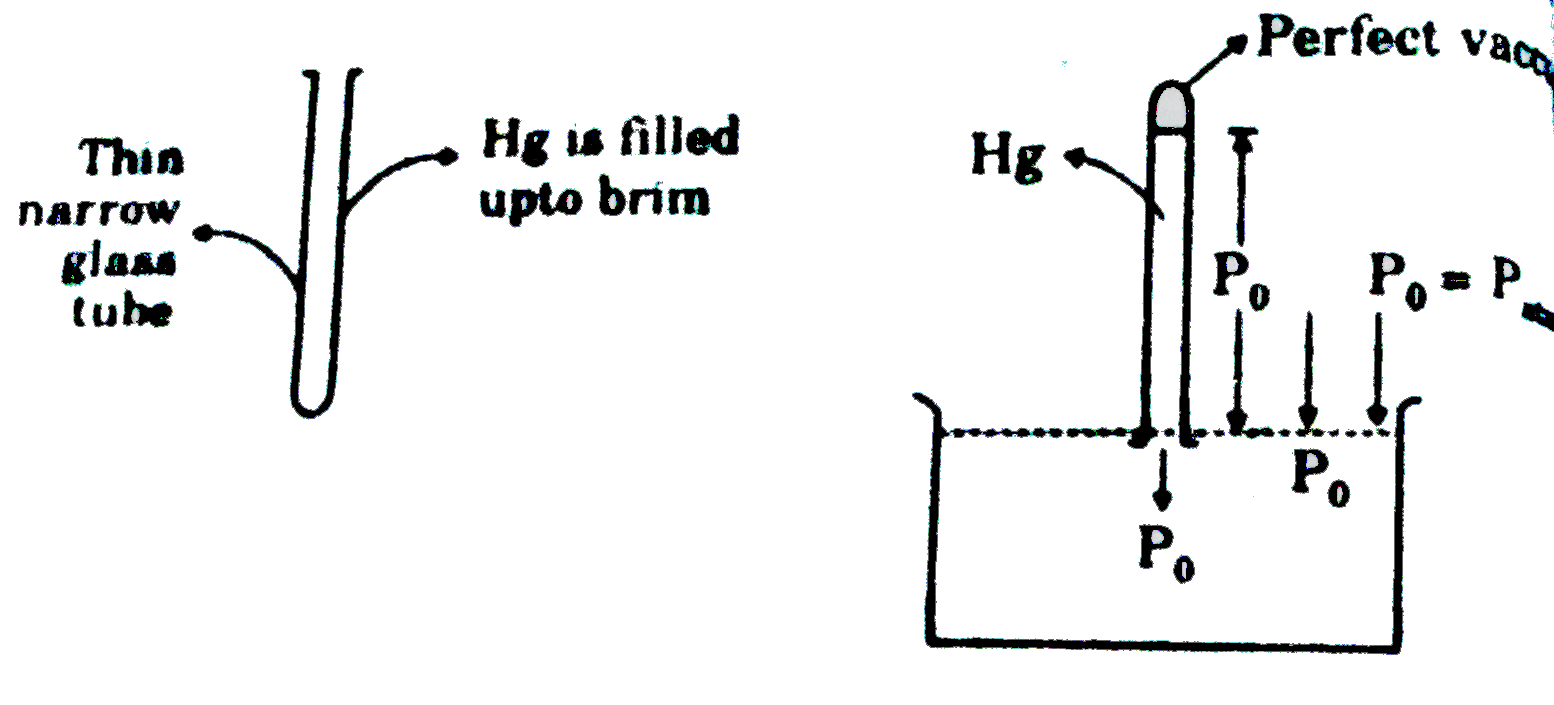
For such a faulty barometer
P0A=mg+PgasA
P0=ρhg+Pgas
or ρgh=P0−Pgas
A tube closed at one end is dipped in mercury as shown in figure such that the closed surface coincides with the mercury level in the container By how much length of the tube should be extended such that the level of Hg in the tube is 5 cm below the mercury level inside the container? (Assume temperature remains constant)
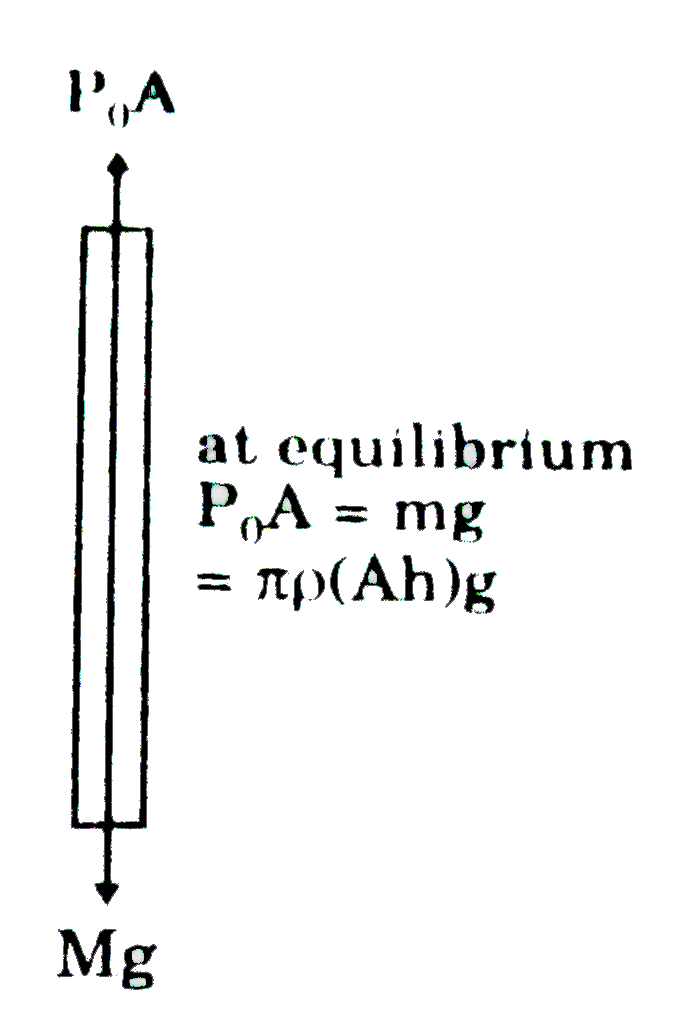
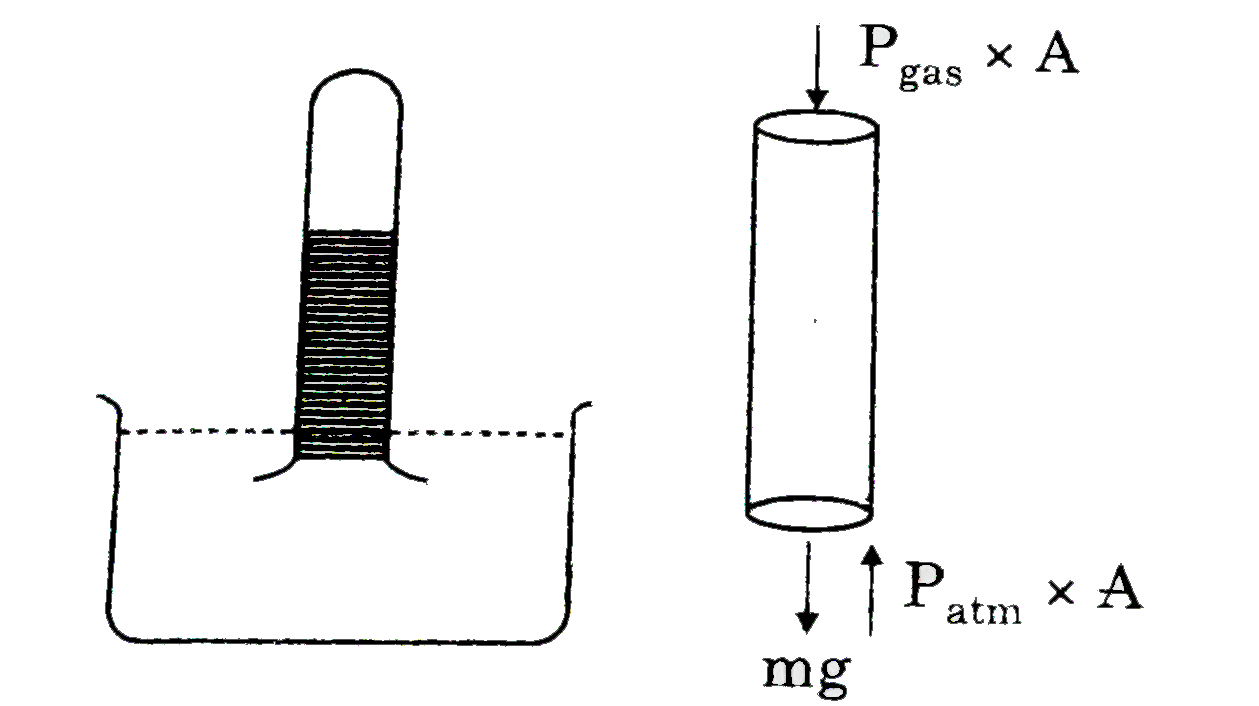
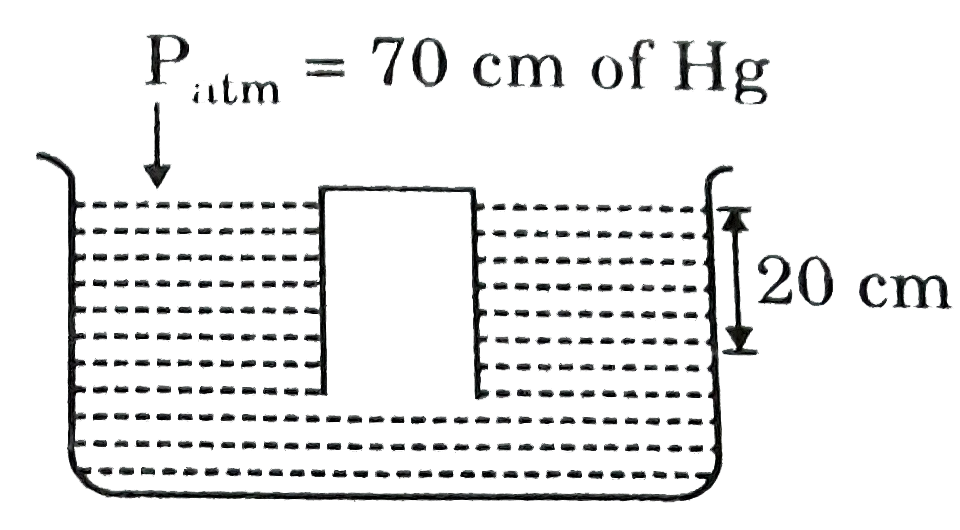 A18 cmB19 cmC24 cmD30 cm
A18 cmB19 cmC24 cmD30 cm
Give reason for the following :
(a) Gases fill up completely the vessel in which they are kept.
(b) Gases exert pressure on the walls of the containing vessel.
View SolutionWe cannot move our fingers through a solid wall. Do you agree? Give reason.
View Solution(a) Why does a gas exert pressure ?
(b) Why does a gas fill a vessel completely ?
(c ) Why are gases so easily compressible whereas it is almost impossible to compress a solid or a liquid ?
View SolutionA cylindrical container of height 3L and cross sectional area A is fitted with a smooth movable piston of negligible weight. It contains an ideal diatomic gas. Under normal atmospheric pressure P0 the piston stays in equilibrium at a height L above the base of the container. The gas chamber is provided with a heater and a copper coil through which a cold liquid can be circulated to extract heat from the gas. Volume occupied by the heater and the liquid coil is negligible. Following set of operations are performed to take the gas through a cyclic process.
(1) Heater is switched on. At the same time a tap above the cylinder is opened. Water fills slowly in the container above the piston and it is observed that the piston does not move. Water is allowed to fill the container so that the height of water column becomes L. Now the tap is closed.
(2) The heater is kept on and the piston slowly moves up. Heater is switched off at the time water is at brink of overflowing.
(3) Now the cold liquid is allowed to pass through the coil. The liquid extracts heat from the gas. Water is removed from the container so as to keep the position of piston fixed. Entire water is removed and the gas is brought back to atmospheric pressure.
(4) The circulation of cold liquid is continued and the piston slowly falls down to the original height L above the base of the container. Circulation of liquid is stopped. Assume that the container is made of adiabatic wall and density of water is ρ. Force on piston due to impact of falling water may be neglected.
(a) Draw the entire cycle on a P–V graph.
(b) Find the amount of heat supplied by the heater and the amount of heat extracted by the cold liquid from the gas during the complete cycle.
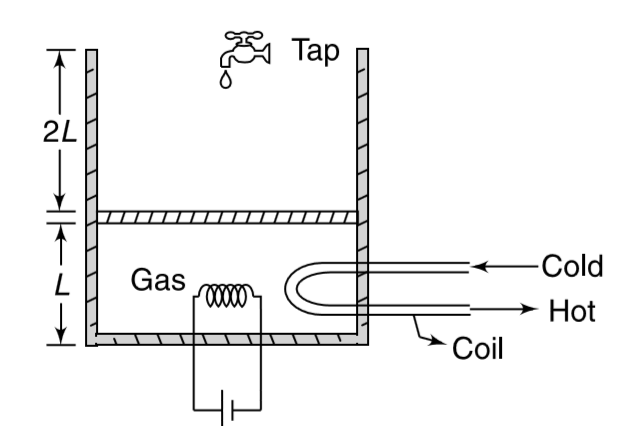
View SolutionWhich of the following statements is wrong for gases?
(a)Gases do not gave a definite shape and volume
(b)Volume of the gas is equal to volume of container confining the gas
(c)Confined gas exerts uniform pressure on the walls of its container in all directions
(d)Mass of gas cannot be determined by weighing a container in which it is enclosed
View SolutionTwo vessels A and B of equal volume (V0) are connected by a narrow tube which can be closed by a value. The vessels are fitted with piston which can be moved to change the volumes. Initially, the valve is open and the vessels contain an ideal gas (CpCv=γ) at atomspheric pressures(P0) and atmoshpeheric temperature (T0). The walls of the vessels A are diathermic and those of B are adiabatic. The value is now closed and the pistons are slowly pulled out to increase the volumes of the of the vessels to dobuled the original value.(a) Find the temperatures and pressures in the two vessels. (b) The value is now opened for sufficeint time so that the gases acquire a common tempertures and pressures . Find the new values of the temperatuere and the pressures.
View SolutionGive reasons for the following.
(a) Liquids can be taken in an open container while gas requires a closed container.
(b) Honey cannot be poured into another container as easily as water
(c) Gases flow more than liquids.
(d) As water is subjected to heating, its temperature increases and becomes constant at 100∘C even though water is still there in the container and the supply of heat is continued.
(e) When a solid substance is subjected to heating, it dissappears without leaving any liquid.
View Solution
